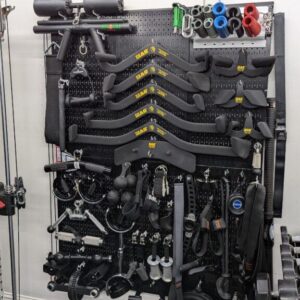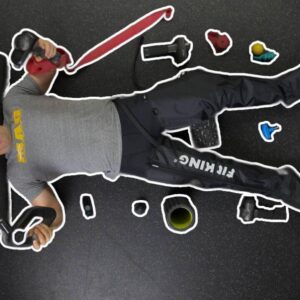New Dad Training – 5+ Tips and Tricks to Continue Powerlifting CORRECTLY With A New Kid In The House
Training and having a newborn aren’t exactly two things that go hand in hand. Check any of the articles in the past several years about heavy lifting and they all talk about sleep. Sleep is the fundamental aspect to recovery, hormones, healthy digestion, injury prevention, performance, and more. But sorry, for anywhere between 2 months and 2 years, you don’t get any with a newborn. In today’s article I’m going to share my experiences of the first month of my first born child.
I’ll compare it to the first month of my second born, in what I call New Dad Training. This article will be written from the perspective of a dad, but can easily be applied to anyone juggling being a new parent and lifting.

Table of Contents
Transparency Note
Some of the items and links in this article might be affiliate links, or might be linked to a Sponsor of the Garage Gym Competition. These links and sponsorships help fund the website, the competition itself, the newsletter, non-profit donations, and everything else we do FOR FREE here at the GGC. I like to be transparent so you know what is up. I appreciate the support if you choose to use the links.
What Training Looked Like – Pre Dad
My general week of lifting before my children were born would hit a 4 day split with mini-workouts thrown in between.
- Monday = Max Effort Lower (approximately 2 hours)
- Tuesday = “WALRUS” (Wendler) style workout where there is a good amount of volume of bodyweight squats, push ups, lunges, and pull ups with book ended bits of steady state cardio on a bike or run. (Approximately 1 hour)
- Wednesday = Max Effort Upper (approximately 2 hours)
- Thursday = Steady State Cardio and stretching (Approximately 1.5 – 2 hours)
- Friday = Dynamic / Repetition Lower (Approximately 1 hours)
- Saturday = Dynamic / Repetition Upper (Approximately 1.5 hours)
- Sunday = Total Rest / Hike in the Mountains
What I Learned – The Hard Way
When my first child was born, I made little to no changes in my training. This tanked my recovery and my training suffered more and more as me and my wife didn’t have much of a support system outside of each other. This increased my frustration when I was missing lifts I should have gotten with ease. As I went through each 3 week wave the movements got slower and the swelling in my joints (specifically my spinal fracture and knees) got noticeably worse.
I felt I had stalled because I wasn’t thinking that waking up every hour or two was inhibiting my recovery. This (with respect to my injury history) ultimately led to a very bad flare up where I over-trained with respect to my recovery and couldn’t walk more than 20-30 steps without laying on the ground for some relief.
In addition to the physical pain, this caused enormous amounts of stress on our household. We had a newborn child that I couldn’t hold or walk with for more than a few steps without being in excruciating pain. This put most if not all of the parenting work on my wife who certainly did not deserve that. I was determined to come back stronger and be a better husband and father.

What Training Looked Like – After My Second Kid
My second child was born almost two years after my first child. I was armed with a new set of knowledge from numerous articles and books I had studied. I cut my training time significantly and doubled the recovery days. Ultimately what I found after after the first month of my second child, was that I totaled only 20 pounds less than my all time personal best recorded several years ago. This was before my injuries. It was more than 70 pounds over my recent PR numbers during the previous years Garage Gym Competition too! The split I followed for the first month of my second child’s birth looked like this:
- Monday = Max Effort Lower (approximately 35 mins)
- Tuesday = Steady State (30 mins)
- Wednesday = Max Effort Upper (Approximately 30 mins)
- Thursday = Complete Rest
- Friday = Repetition Lower / GPP Lower
- Saturday = Repetition Upper / GPP upper
- Sunday = Complete Rest
Goals and Guidelines of New Dad Training
When my second kid was on the way, I started with a general outline for my training goals.
- The intent is to get training in to enhance mental and physical health without sacrificing my duties as a father, husband, and first responder
- Maximize efficiency of time in the gym
- Do. No. Harm. This may be the most important note, you must have a thorough understanding of yourself and what your “warning lights” are especially if you have a significant injury history or are an older lifter.
Let me preface this with saying I’ve been running a Conjugate style program for some years. I’m nowhere near a professional in the subject matter, but it makes sense in my head and continues to work for me and my physical proficiency as a first responder. You could easily adapt these concepts to any program, training concept, or general workout. One program that I know is well regarded is JuggernautAI . The app will ask you questions daily about your sleep and general preparedness for your workout, and then adapt the days training to fit. If you are interested or open to this option, check out the article on the app here.


Since listening to JM Blakely’s table talk, I understand that recovery and training have to be in near perfect harmony. So, if you have a new kid in the house and are learning all the new stuff about being a parent, taking on more responsibilities around the house, maybe missing a meal or two here or there, or… missing sleep! You are going to have to dial back your intensities in training for the time being.
Professional athletes and some specific circumstances can be a little different. They might hire someone to help alleviate these stressors, wake up with their kid at 2am, and allow them to train hard and heavy regardless of what is going on in the household. For the rest of, time to adapt!
The Key to New Dad Training is Attitude and Honesty
Dialing back your intensities or volumes may come as a shock at first, it certainly did to me, but you’d be surprised how much strength you can retain over a longer period of time. Dialing things back will help in your recovery and help retain the majority of your hard earned gains. And it is FAR better than simply dropping training entirely. It’s important to state that though we are dialing back intensities and durations, we are fully attacking our weaknesses and not just focusing on the things we are good at. We are still trying to improve ourselves for our own health and for the betterment of our children.
This was stated in Dan Grigsby’s table talk episode, where he mentioned while training for various powerlifting meets that his cycles would be interrupted by random, unplanned field ops during his time in the military. The field ops could last anywhere from a few days to several weeks. Grigsby was surprised to learn that when he would come back, he retained a large amount of the strength he had prior to leaving. This is important to keep in mind as your mentality maintained throughout this event plays a very big factor.
Understanding that we can draw back the intensity and volume for a brief period with minimal penalty, I intended to keep working on my weak points, but keep time away from the family to a minimum. The longest session I had during my second child’s first month of life was 42:36. This session was a max effort lower, and I was still figuring out how to cut down time in the gym while still respecting my rehabilitation needs.
By the end of the month, my training time averaged 25 minutes and 8 seconds, and I felt that I was getting adequate work for my recovery levels. The significantly shorter training times allowed me to be more present for my wife and my two children. This also allowed me to be less selfish and allowed my wife to have her very well deserved time to herself.
Tips and Tricks To Make New Dad Training Work
There were a few tips I picked up along the way which dramatically changed my training for the better. First, only change your shoes, and maybe your shirt if you’re a sweatier individual. Stretchy pants from Costco or 5.11 are extremely durable and are great to workout in. This cuts down “away time” and lets you dedicate the short amount of time you have to training. This might sound trivial, but when you shave 5 mins of changing clothes that’s another round of exercises you could have executed.
Next, start a timer. This puts your training time in perspective and made me more conscious of my wife’s time as well. For my Dynamic Effort days I would set a timer that will go off every :45 so I would complete my 12×2 in about 9 minutes (Thanks for the tip Laura Phelps). Then begin your workouts with some sort of circuit that allows you to prime several areas of your body. An example might be – air squats, lunges, jumps, with planks for 20 reps each (0:30 planks) and 4 rounds.

Last, prioritize training that you can recover from better. Skip the max out singles and leave them for the next GGC event. Instead opt for 2-5 rep efforts. If doing speed work with bands beats you up, opt for straight weight sets. If you’re strictly in a hypertrophy stage (against my recommendation during this chapter of your life), instead of finishing a set with 1-2 reps in reserve, leave 3-4 in the tank.
Choose things that let you continue to train hard consistently, but you can come back from it in one piece. Think of things that don’t leave you too beat up to pick the baby up off the floor. I would remind myself of these facts during the training to keep things in perspective. My training supplements my life, not the other way around.
Don’t Skip The Cardio w/ New Dad Training
One thing I can attest to is I recovered better in the days following some sort of cardio. Now, this doesn’t have to be a dedicated gym session. You could even give mom a break and strap the kid to your chest and go for a long walk! Several studies show that light aerobic activity positively affects mood and general disposition.
Without going into significant detail, this will help your mentality while missing sleep, meals, and your general routine. I would also recommend experimenting with this before the baby comes to find out which cardio you “like” the best as it will be most sustainable for you. (Examples; walks, jogs, sled drags, rowing, hiking, stair climber, incline treadmill walks, bike, assault bike, etc…)
Wrap Up
Having a home gym definitely made things much easier for us during this time. If my wife was having a difficult time getting the toddler down for his nap, I was a short walk away to lend some assistance. I believe this took a good amount of stress out of the situations we faced. I strongly encourage anyone to have a minimum of a barbell and some weights at home (and maybe some bands and rings) in order to curve the “away time” down.
Removing a drive from the equation could save you 30 minutes of training. I think the used market is about to heat up, so keep an eye on the local market but in the event I’m wrong, please see the discount codes to save a few bucks where you can, and hunt for sales during holidays.
Everything I’ve put in this article is what worked best for me during the first month. New Dad Training isn’t meant to be a “program” per se, but instead an idea of how to help navigate that first stage of sleep deprivation and new parent needs. Now, I must add if you’re a new parent reading this, there are so many other variables that you have to account for yourself. Postpartum is difficult for both parents. Allow yourself and your significant other some grace. This is a new adventure, I hope you have as successful of a first month as I did. Click here for another great article on this topic.

Please feel free to reach out with any questions or anything I can help with. I’m looking forward to learning with you all.
New Dad Training was written by Chris Key, check out his other happenings right here.
📌Enjoy Powerlifting? Want to enter a FREE competition with thousands of dollars in prizes and donations to non-profits? Check out our next event!
🏅 Own a home gym? Like to save money? Check out my full list of discount codes.



